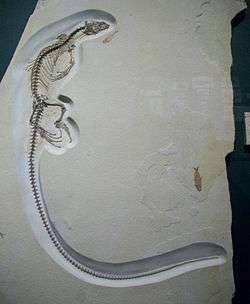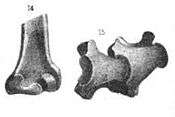Saniwa
| Saniwa Temporal range: Eocene, 48 Ma | |
|---|---|
 | |
| Skeleton of Saniwa ensidens in the Field Museum of Natural History | |
| Scientific classification | |
| Kingdom: | Animalia |
| Phylum: | Chordata |
| Class: | Reptilia |
| Order: | Squamata |
| Family: | Varanidae |
| Genus: | †Saniwa Leidy, 1870 |
| Species | |
| |
| Synonyms | |
| |
Saniwa is an extinct genus of monitor lizards that lived during the Eocene epoch around 48 million years ago. Well-preserved fossils have been found in the Bridger and Green River Formations of Wyoming, and evidence indicates Saniwa also lived in Europe. The type species S. ensidens was named in 1870 as the first fossil lizard known from North America. Several other species have since been added, but their validity is uncertain. It is a close relative of Varanus, the genus that includes extant monitor lizards.
Description

Saniwa grew to around 1.3 m (4.3 ft) in length, though S. grandis could reach 2.15 m (7.1 ft).[1] Like other monitor lizards, Saniwa has a long, pointed snout and nostrils placed farther back in the skull than most lizards. The tail is almost twice as long as the rest of the body.[2] Although similar in appearance to living monitor lizards, Saniwa has several primitive traits, including teeth on its palate, a jugal bone beneath the eye that extends farther forward, and a suture between the frontal and parietal bones that is straight rather than curved or wavy.[3]
History and species
In 1870, American geologist Ferdinand Vandeveer Hayden found the first fossils of Saniwa near the town of Granger, Wyoming, and gave them to paleontologist Joseph Leidy.[2] Later that year, Leidy described the type species Saniwa ensidens on the basis of these fossils. Saniwa was the first extinct lizard to be named from North America.[4] The first remains of S. ensidens were preserved as black bones in marl that was part of the Bridger Formation. Hayden suggested the name Saniwa to Leidy because it was "used by one of the Indian tribes of the Upper Missouri for a rock-lizard."[5] Leidy saw a close similarity between Saniwa and the living Nile monitor.

Although his first description was brief, Leidy studied the genus thoroughly and provided illustrations in an 1873 paper. In this paper, Leidy called it Saniwa. He also named a second species, Saniwa [sic] major, on the basis of a broken humerus and some isolated dorsal vertebrae.[5] In 1918, Baron G. J. de Fejérváry suggested that S. major was not a species of lizard, noting that the humerus was "undoubtably" nonreptilian.[6] Leidy even pointed out similarities between the bone and those of birds in 1873.
Soon after Leidy named Saniwa, American paleontologist Othniel Charles Marsh erected the genus Thinosaurus in 1872 for several species of extinct lizards in the western United States. He never published a full description of these lizards, and Thinosaurus was later considered a junior synonym of Saniwa. The species T. leptodus was synonymized with S. ensidens, but all other species have remained distinct, including T. agilis, T. crassa, T. grandis, and T. paucidens.[2]

In the 1920s, much of the holotype specimen of S. ensidens was prepared by removing marl from around the bones. This revealed many new features of Saniwa, including the underside of the skull and parts of the vertebrae. American paleontologist Charles W. Gilmore restudied the holotype and described new features in 1922.[4] He described many of these features from a fragment of the snout and lower jaw. Although this fossil was well preserved, it was not found in the same block of marl as other parts of the specimen. This fossil was reexamined in 2003 and was found to belong to a xenosaurid lizard, not Saniwa.[7]
Fossils from many other parts of the world have been assigned to Saniwa, although all are fragmentary. In 1899, Argentine paleontologist Florentino Ameghino named another species of Saniwa, S. australis, from lower Miocene rocks in Argentina. It is now considered a dubious name, because the material cannot be assigned with confidence to Saniwa. S. orsmaelensis was described from Belgium in 1923, but because its naming was informal, it was designated a naked name. S. orsmaelensis was later suggested to be either synonymous with S. ensidens or a different, indeterminate species of Saniwa. Unlike the Argentine fossils, the Belgian remains represent a definite occurrence of Saniwa outside North America.[2] S. feisti was named from the Eocene Messel Pit in Germany in 1983.[8] S. feisti is no longer considered to be a species of Saniwa, but a more primitive member of the family Varanidae.[3]
A complete and articulated skeleton of S. ensidens was described from the Green River Formation of Wyoming in 2007. It preserves soft tissues like scales, cartilage between bones and in the sternum, and even the trachea. The individual is thought to have been a juvenile.[2]
Classification
Since its first description, Saniwa has been recognized as a close relative of living monitor lizards in the genus Varanus. It is a member of the family Varanidae. Saniwa ensidens is often placed as the sister taxon of Varanus in phylogenetic analyses, meaning it is more closely related to Varanus than any other varanid. Below is a cladogram from Conrad et al. (2008) that shows a sister-group relationship between Saniwa ensidens and Varanus:[3]
| Varanoidea |
| ||||||||||||||||||||||||||||||||||||||||||||||||||||||||||||
| |
References
- ↑ http://www.docstoc.com/docs/84490716/GenusSpecies-Skull-Height-Length-Weight-Stage-Ablepharus--L
- 1 2 3 4 5 Rieppel, O.; Grande, L. (2007). "The anatomy of the fossil varanid lizard Saniwa ensidens Leidy, 1870, based on a newly discovered complete skeleton". Journal of Palaeontology. 81 (4): 643–665. doi:10.1666/pleo0022-3360(2007)081[0643:TAOTFV]2.0.CO;2.
- 1 2 3 Conrad, J.; Rieppel, O.; Grande, L. (2008). "Re-assessment of varanid evolution based on new data from Saniwa ensidens Leidy, 1870 (Squamata, Reptilia)" (PDF). American Museum Novitates. 3630: 1–15. doi:10.1206/596.1.
- 1 2 Gilmore, C.W. (1922). "A new description of Saniwa ensidens Leidy, an extinct varanid lizard from Wyoming" (PDF). Proceedings of the U.S. National Museum. 60 (23): 1–28. doi:10.5479/si.00963801.60-2418.1.
- 1 2 Leidy, J. (1873). Contributions to the extinct vertebrate fauna of the Western Territories. Report of the United States Geological Survey of the Territories. 1. United States Government Printing Office. p. 358.
- ↑ Fejérváry, G.J. de (1918). "Contributions to a monography on the fossil Varanidae and Megalanidae" (PDF). Annales Historico-Naturales Musei Nationalis Hungarici. 16: 341–467.
- ↑ Caldwell, M.W. (2003). "Holotype snout elements of Saniwa ensidens reassigned to cf. Restes sp. indet. (Xenosauridae)". Journal of Paleontology. 77 (2): 393–396. doi:10.1666/0022-3360(2003)077<0393:HSEOSE>2.0.CO;2.
- ↑ Stritzke, R. (1983). "Saniwa feisti n. sp., ein Varanide (Lacertilia, Reptilia) aus dem Mittel-Eozän von Messel bei Darmstadt" (PDF). Senckenbergiana Lethaea. 64 (5-6): 497–508.